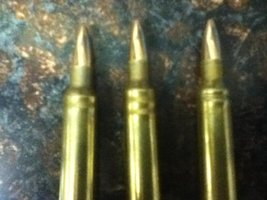headednorth
NES Member
- Joined
- Apr 9, 2012
- Messages
- 26,816
- Likes
- 49,537
Update- see post #11
I loaded up some 223 today, tumbled and while checking them noticed that about a dozen have an odd wrinkle in the case just below the shoulder. Some just a slight wrinkle, a few pretty severe.
Some background- I had processed these partially prior to today. Cleaned, de-primed, re-sized, and checked for length with a gauge. Had a batch of 100 or so that didnt need to be trimmed so these were the ones I charged and seated bullets in. I didnt notice any defects in the cases I did today and I looked in the tub I had been sorting for length and found none with a similar defect, so Im 99% certain it happened during the seating operation. Cant see how it would of happened during charging or tumbling and those were the only other operations I did today. All bullets were seated within a few thousands of 2.200.
My only theories at this point are...
-the bullet went in a bit cock-eyed and it crumpled the case as it was seated. But the necks are all in good shape, the damage is below/at the shoulder. I would think that the necks would of borne the brunt of the damage if this was the case.
-I used 25.5 grains of Varget which brings the powder pretty much up to the neck, not leaving a whole lot of room for the bullet. I was thinking the little bit of air between the top of the powder and the base of the bullet is being compressed as the bullet is being seated causing the case to be damaged. (not likely, imo, but who knows.) I'd think the case would be bulged out rather than crumpled.
I loaded maybe 10 dummy rounds using the cases from the tub I got the others from and wasnt able to duplicate the the wrinkles in the case. This was a bullet loaded into a case- no primer or powder so if the compressed air theory is any good, the air would of escaped out of the flash hole. Same batch of cases and same batch of bullets.
Im aware of dents being put into the shoulder due to too much lube during the re-sizing operation. These were all re-sized earlier and I didnt see any damage then or in the ones in the same batch that I looked through today. Also every once in a while, I notice theres a little ridge formed into the shoulder. Almost like theres a flare where the shoulder meets the body of the case. What I saw today is a first for me though. Much worse than the slight flare Ive seen before. Ive attached a pic below. Anyone ever see this or have any idea whats causing it?
eta- sorry for the crappy ipod touch pics...

I loaded up some 223 today, tumbled and while checking them noticed that about a dozen have an odd wrinkle in the case just below the shoulder. Some just a slight wrinkle, a few pretty severe.
Some background- I had processed these partially prior to today. Cleaned, de-primed, re-sized, and checked for length with a gauge. Had a batch of 100 or so that didnt need to be trimmed so these were the ones I charged and seated bullets in. I didnt notice any defects in the cases I did today and I looked in the tub I had been sorting for length and found none with a similar defect, so Im 99% certain it happened during the seating operation. Cant see how it would of happened during charging or tumbling and those were the only other operations I did today. All bullets were seated within a few thousands of 2.200.
My only theories at this point are...
-the bullet went in a bit cock-eyed and it crumpled the case as it was seated. But the necks are all in good shape, the damage is below/at the shoulder. I would think that the necks would of borne the brunt of the damage if this was the case.
-I used 25.5 grains of Varget which brings the powder pretty much up to the neck, not leaving a whole lot of room for the bullet. I was thinking the little bit of air between the top of the powder and the base of the bullet is being compressed as the bullet is being seated causing the case to be damaged. (not likely, imo, but who knows.) I'd think the case would be bulged out rather than crumpled.
I loaded maybe 10 dummy rounds using the cases from the tub I got the others from and wasnt able to duplicate the the wrinkles in the case. This was a bullet loaded into a case- no primer or powder so if the compressed air theory is any good, the air would of escaped out of the flash hole. Same batch of cases and same batch of bullets.
Im aware of dents being put into the shoulder due to too much lube during the re-sizing operation. These were all re-sized earlier and I didnt see any damage then or in the ones in the same batch that I looked through today. Also every once in a while, I notice theres a little ridge formed into the shoulder. Almost like theres a flare where the shoulder meets the body of the case. What I saw today is a first for me though. Much worse than the slight flare Ive seen before. Ive attached a pic below. Anyone ever see this or have any idea whats causing it?
eta- sorry for the crappy ipod touch pics...

Last edited:
